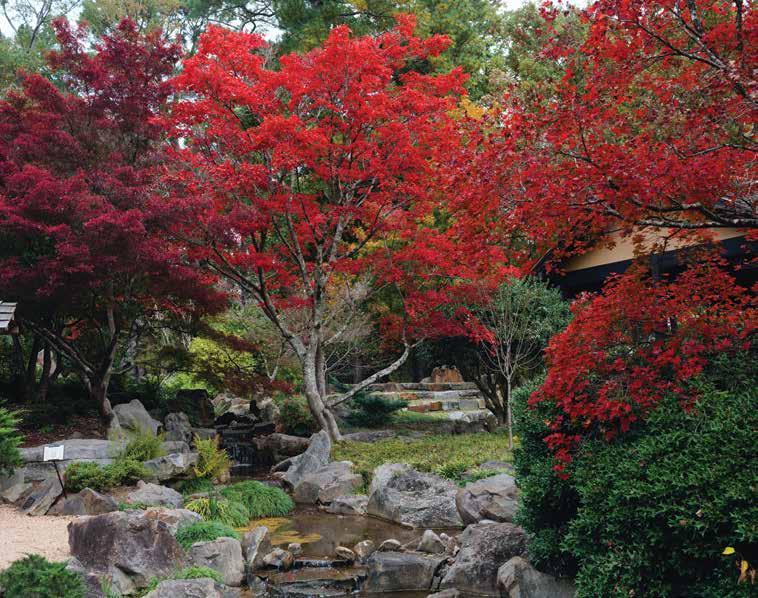the garden dirt
FOR FRIENDS OF BIRMINGHAM BOTANICAL GARDENS
DISCOVERING PASSION AND PURPOSE THROUGH

DISCOVERING PASSION AND PURPOSE THROUGH
A new horticulturist sees opportunities for revitalization and continued cultivation of this beloved community treasure
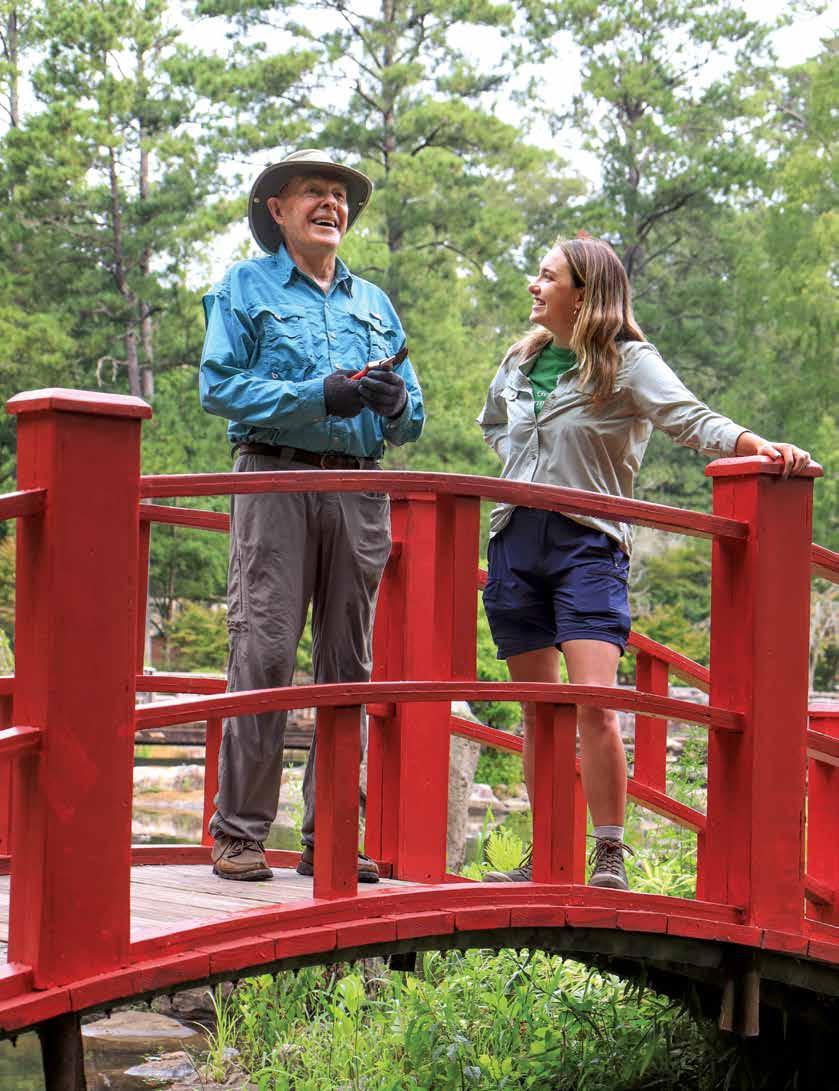
Your annual membership in the Friends of Birmingham Botanical Gardens helps keep these beloved Gardens growing. Be sure to take advantage of these great member benefits. Thank you for supporting this urban oasis and all that it makes possible!
Enjoy Member Priority Shopping on Thursday, Sept. 7, and be sure to stop by the membership table near the entrance to the sale on Sept. 7–9 to pick up your annual Member Plant Gift—a Satsuki azalea courtesy of Leaf & Petal! A perfect plant for bonsai or any garden. Jump to page 6 to learn how to care for bonsai.
Members at the Friends ($50) through Supporter ($250) levels will receive one complimentary, single-day general admission to our 2023 show on the day of their choice. Members at the Ambassador ($500) and Benefactor Circle ($1,000) levels will receive two complimentary three-day general admission tickets. Members of the Friends also receive 10% off advance book purchases at Leaf & Petal at the Gardens (in store only, through Sept. 27); simply show your membership card at the door!


Enjoy 10% off select purchases at our member partners! Visit bbgardens.org/membership for details.
DOROTHY MCDANIEL’S FLOWER MARKET
FARMSTAND BY STONE HOLLOW
LEAF & PETAL AT THE GARDENS
PETALS FROM THE PAST
• HOUSE PLANT COLLECTIVE
• MYERS PLANTS & POTTERY
• SHOPPE/GENERAL
SWEET PEAS GARDEN SHOP
• WILD THINGS
Emily Bowron Chair
wally Evans immEdiatE Past Chair
d�C Coston trEasurEr
KirK ForrEstEr sECrEtary
dEriCK BEldEn Chair oF CommuniCations & marKEting
EvElyn JonEs Chair oF dEvEloPmEnt
CarolinE littlE Chair oF EduCation & Community EngagEmEnt
John smith t Chair oF govErnanCE
liBBa vaughan Chair oF govErnmEnt rElations
lEE mClEmorE Chair oF oPErations
Uday Bhate
Maggie Brooke
Sharon L. Brown
Sharon Deep Nelson
Eleanor Estes
Wendy Evesque
David Germany
Helen Harmon
Leigh Haver
Janet Kavinoky
Blevins Naff
Tiffany Osborne
Ruffner Page, Jr.
Sharon Sherrod
Martha Emmett Sims
Ellen Spencer
Larry D. Thornton, Sr.
Jesse Vogtle, Jr.
Ginny Willings
Jim Pickle, Junior Board President
The Friends of Birmingham Botanical Gardens seeks to protect, nurture, and share the wonders of Birmingham Botanical Gardens. We are dedicated to serving the Gardens, serving the community, serving our visitors, and inspiring a passion for plants, gardens, and the environment.
Tom Underwood.....................................................Executive Director
Julia Adams Horticulturist—Japanese Garden
Stephanie Banks Chief Financial Officer
Katelyn Bahr Horticulturist—Specialty Gardens
Dawn DeFrank Donor Service Coordinator
Paige Goldschmidt….....................................Development Associate
Amelia Haas Office Coordinator
Ellen Hardy Education Program Coordinator
Penney Hartline Director of Development
Cassia Kesler Director of Communications & Marketing
Jason Kirby Library Assistant & Archivist
Hope Long Director of Library Services
Tina Nelson Accounting Clerk
Félix Ortiz ….................. Communications & Marketing Associate
Drew Rickel Donor Relations Officer
Keith Turney Horticulturist—Kaul Wildflower Garden
Jane Underwood Director of Gardens Support
Editor: Cassia Kesler
Art Design: Ellen Padgett
Cover & Lead Photos: Félix Ortiz
Contributors: Julia Adams, Susan Alison, Dawn DeFrank, Amelia Haas, Penney Hartline, Molly Hendry, Wendy Wallace Johnson, Dawn Coleman Lee, Hope Long, Tyler Mason, Félix Ortiz, Drew Rickel, Graham Yelton
©2023 Friends of Birmingham Botanical Gardens. All rights reserved. 2612 Lane Park Road, Birmingham, AL 35223 205.414.3950 | bbgardens.org communications@bbgardens.org
A facility of the Birmingham Park and Recreation Board, Birmingham
Botanical Gardens is the result of a public/private partnership between the City of Birmingham and the nonprofit Friends of Birmingham Botanical Gardens, a mission-driven membership organization that seeks to protect, nurture, and share the wonders of the Gardens. We hope you enjoy this issue of the Friends’ award-winning quarterly publication, The Garden Dirt.
Thank you for visiting and supporting the Gardens!
Friends of Birmingham Botanical Gardens practices a policy of equal opportunity and equal access to services for all persons regardless of race, creed, color, national origin, age, disability, veteran status, orientation, or gender identity.

As the warm, bright, sunny days of summer begin to mellow into the cooler days of autumn, the changing of the seasons mirrors a time of transition for Friends of Birmingham Botanical Gardens. We are offering farewells and best wishes to a few beloved staff members, along with our summer interns, all of whom are moving on to new, exciting opportunities. Their diligent work and accomplishments at the Gardens have prepared them for bright futures.
The new season is a time to extend a welcome as well—I am pleased to share that we have a new full-time horticulturist dedicated to the Japanese Garden, Julia Adams. We are excited to have Julia join our team to help us carry on with the great work of our volunteers and gardeners who share a similar love for the garden’s beauty and rich traditions. Learn more about recent improvements and Julia’s thoughts about her work in the Japanese Garden in the feature story on page 2.
In late June, we were honored to be a part of an ongoing effort by the Garden Conservancy to document significant gardens across the country and the people who have created them. Longtime friend of the Gardens and author of “Listen to the Land,” Louise Wrinkle and her woodland garden were the focus of this installment filmed here in Birmingham. We were honored to host the production crew for a day of interviews here at the Gardens.
Each year we celebrate the arrival of the season with our annual Fall Plant Sale. This fundraiser takes place September 7–9 at the Gardens, and offers hundreds of plants specially selected for your home garden, as well as volunteers at the ready with invaluable gardening advice. As a special thank you to our members, we will once again have a Member Plant Gift. This year’s plant will be a Satsuki azalea (Rhododendron indicum ‘Osakazuki’). A small, evergreen shrub, the Satsuki azalea is well suited for training as a bonsai. Learn tips for growing bonsai on page 6.

Gain inspiration for home and garden by joining us for the 17 th annual Antiques at the Gardens! This year’s Gala will honor longtime Gardens supporter and former board chair Hanson Slaughter. Our co-chairs, Jennifer Ard, Jeremy Clark, and Kirk Forrester, and their dedicated committee have assembled an impressive lineup of internationally acclaimed speakers and curated vendors specializing in antiques, furniture, fine art, interior design, and floral artistry. Learn more about Antiques at the Gardens on page 10.
We look forward to all that lies ahead this fall and seeing the many people who come together for these exciting events, year after year, to ensure that these beautiful Gardens can continue to thrive and grow. We thank you for your Friendship.
Tom Underwood Executive Director, Friends of Birmingham Botanical Gardens
Renowned for its beauty, tranquility, and harmony, the Japanese Garden has been a beloved destination for visitors from around the world and a signature aspect of Birmingham Botanical Gardens for over 50 years.

As we honor and remember the past, and as the Japanese Garden has grown and shifted over time, a dedicated cadre of FBBG volunteers, supporters, and City staff are passing along their wisdom to
others who share a similar enthusiasm for cultivating its many wonders. This summer, Friends of Birmingham Botanical Gardens hired a new horticulturist, Julia Adams, to lead our efforts in the Japanese Garden. This season, we celebrate the hope of new growth and progress, as we honor the history of this iconic and beloved place of serenity and contemplation.
Originally opened in 1967 in a ceremony led by Ryuii Takeuchi, the Japanese ambassador to the United States, the garden encompasses 7.5 acres and consists of multiple smaller gardens, each intended to offer visitors a different encounter. At
the time, it was the largest Japanese garden in the United States. “It’s designed as a strolling garden to walk through, pause, and experience multiple views, perspectives, and sensations, element by element,” said Norm Geisinger, longtime volunteer and tour guide for the Japanese Garden.
While working in the Japanese Garden at the Denver Botanic Gardens and at the University of Tennessee at Knoxville, Julia was captivated by the artistry and history of the practice. She is eager to continue the legacy of the Birmingham garden. “This space has amazing bones,” said Julia.
“It’s a real honor to be trusted with this
space. I feel so lucky to be able to work with a group of volunteers with such a rooted history. It’s a wonderful network to be able to reach out to.”
With the help of volunteers who have diligently and lovingly maintained the garden for years, Julia immediately dove into projects such as weeding, pruning, clearing out dead and damaged bamboo, and embarking on multilayered research of the history of the garden, which is carefully preserved by Jason Kirby, archivist for Friends of Birmingham Botanical Gardens. The Japanese Garden archives are the largest part of the collection. “I want to learn more about its history as being connected to members of this community, across the nation, and really across the world. It has such a rich history and holds such a warm place in so many people’s hearts,” said Julia.
“I’d like to keep the Japanese Garden as true to what it is currently at this moment, while also focusing on what’s healthiest for the plants, and sustainability for the future—being able to maintain it properly,” said Julia. “For example, we’re removing dead shrubs that didn’t make it through the hard freeze this past winter, and we may not be using those same shrubs again. But in the most respectful way, we can cultivate it in such a way that’s true to this place, and help it to flourish according to the underlying principles of Japanese garden design.”
Her sentiment mirrors what the builder of the traditional tea house, Mr. Kazunori Tago, once said: “Even ancient styles should continue to develop, and new structures should be a fulfillment, not just a rehash.”
As part of her research, Julia has created a map of the Japanese Garden based on architect Mr. Masaji “Buffy” Murai’s original design, and divided it into seven phases or zones that she will focus on maintaining and improving with the help of experienced volunteers. “They have such a long-standing history in this place, along with community supporters, and City staff such as Adam Benjamin, who cared for this garden for several years. I have such a wonderful network of people to lean on for help. I have found it so warm and welcoming,” said Julia.
Walking through the Japanese Garden is like being immersed in a living painting. At every vantage point, carefully cultivated vistas composed of four integral elements—rock, water,
vegetation, and hand-built structures— greet the viewer in a beautifully woven tapestry of function, texture, symbolism, and serene contemplation. The placement and care of each rock, shrub, tree, and water element is intended to frame a view, from any vantage point.
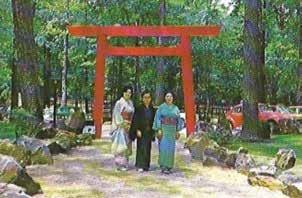

“I’m focusing my physical work around the structures, and then researching the history of those structures,” said Julia.
OPPOSITE:
The Bridge of Accomplishment, also known as the “Zigzag Bridge,” carries visitors across Long Life Lake and offers views of the brightly colored koi inhabiting the pond. The Zigzag Bridge represents the turning points in life that can take us in unexpected directions. ABOVE, RIGHT: The original Torii was built in 1967 in the Shinmei style. (Source: Archives & Rare Book Room at the Library at the Gardens). ABOVE: Julia Adams and a group of dedicated volunteers work in the Japanese Garden every Tuesday morning.Grounded in Taoist, Buddhist, and Shinto philosophies, many elements in the Japanese Garden have symbolic quality and are centered on a reverence for nature.

Translated “the gateway to heaven,” the torii is an invitation, at the entrance to the garden. The original torii was a simpler Shinmei-style structure. Updated in 1988 to a Myojin-style torii, it was renovated in 2007 by Dean Black.
“The torii invites you into a sacred space, set apart from the mundane,” explained Norm. “There is also the idea that what you experience on the other side, in the garden, will be transformative.” Not only is the garden visually beautiful, but also as visitors walk through, it offers a connection to nature that inspires transcendence and uplifts the senses and the soul.
Focusing efforts first on better weeding around the trees and shrubs near the torii will be the first step in the process, with the help of dedicated gardeners, and also volunteer groups such as Brasfield and Gorrie, who came out this past summer to help clear the stream bed of weeds.
Tending to monocultures, such as the
mass plantings of liriope is another goal.
“Liriope is a key element that has been used beautifully in this garden,” said Julia. “Sometimes, it is used to mimic the sense of flowing water, or a stream. It’s a different texture from the other ground covers. Ours just needs some tender loving care to get back to its original lush, green state.”
“Karikomi is the art of shearing back,” said Julia, “It’s the overall concept of pruning hedges and bushes into shapes or forms, and maintaining or designing shapes with the shrubs in your garden.” For example, the varying heights of pruned shrubs and trees can be intended to replicate the look of clouds in the sky, a line of mountains in the distance, or the undulating patterns of a forest canopy.
Today, volunteers are focusing on treating other free-growing trees in the garden using bonsai methods and tools to “open the trees,” creating negative space among their branches, and creating a “cloud canopy” of leafy branches above.
Norm Geisinger, who has cultivated bonsai for over 30 years, is now using his skills to cultivate certain trees such as the black

Japanese pine (Pinus thunbergii) and Japanese maples (Acer palmatum) into forms that replicate the art of bonsai on a larger scale.

Cross through the Taylor Gate into the meditative karesansui, or dry rock garden (also known as the Zen garden), where five rock formations of varying height are surrounded by white gravel that is carefully raked into patterns that mimic the undulation of ocean waves around mountain islands—much like the islands of Japan itself. While the gravel may easily change patterns, or become disrupted or unkempt, the solid rocks remain stable, a focal point. “This might also symbolize gaining inner tranquility while being surrounded by a world in flux,” commented Norm.
Beside the karesansui is the beautiful Toshinan, or traditional tea house. The word toshinan can be translated, “a house where those gathered can light a wick [of understanding] in each other’s hearts.”
1. Kasuga Lantern
The larger, 12-foot-high granite Kasuga Lantern nestled within the bamboo grove was donated by our sister city of Hitachi, Japan, in 1985. Weighing over five tons, the tachi-gata, or pedestal lantern, is inscribed “Showa 60 (1985) Spring,” marking when it was donated during Emperor Showa’s 60th year of reign. The Kasuga Lantern was originally located at the southernmost point of the garden, where Cahaba Road and Lane Park Road intersect. It was moved to its current location in 2018, and the planting around it was done in memory of Dr. Bob Wendorf, a dedicated volunteer and supporter of the Japanese Garden.




2. Snow-Viewing Lantern
The Yukimi Doro, or Snow-Viewing Lantern, can be traced back to the Edo Period. This style consists of a six-sided light box, and typically sits on four legs but may have three to six legs. The kasa, or roof, is typically wider and broader than other lanterns and can be round or have anywhere from three to eight sides. This lantern was also a gift from the city of Hitachi, Japan.
3. Spirit Lantern
This is an Obakedouro, or Spirit Lantern, in a traditional planet shape. This lantern is made of red kurama granite and can be dated to the Taisho-Showa Period. It was sourced from a private garden located in Nagoya, Japan. It was selected for its red granite with bands of iron ore, which connect to the iron ore found within our very own Red Mountain. This lantern was donated by the ITOCHU Coal Americas Inc. and found its permanent home within our Japanese Garden in 2019.

4. Three-legged Snow-Viewing Lantern
The other yukimi doro is much smaller than the one donated by Hitachi and rests on three legs. This style of lantern is typically placed near bodies of water to light the way to shore for travelers, measure tides and water levels, and to create a scenic view over bodies of water. Three-legged yukimi doro typically have one leg placed on land while the other two are located in the water. This gives a way to keep measurement of water levels for boats to know whether or not it’s safe to dock.
5. Oribe Lantern
The Oribe Lantern was originally designed by and named after a famous tea master, Lord Furuta Oribe who lived in the 1500-1600s. This lantern was created to light paths within tea gardens and is typically a very simple design consisting of a four-sided light box, gently slanting roof, and a rounded houju finial on top. This is an ikekomi doro, buried lantern, meaning the base is not visible and it appears as if the post is planted directly into the ground. It is dedicated to our sister city, Maebashi, Japan.
6. Lilly Oribe Lantern
This lantern is in the same oribe style, and also an ikekomi doro. This specific lantern, however, is dedicated to Lilly Kimata Eagleson, Omotesenke Tea Master. Lilly was a longtime tea master and caretaker of the tea house and garden. This lantern sits directly next to the tsukubai, the washbasin used to purify oneself before participating in a tea ceremony.

7. Tea Garden Kasuga Lantern
Another kasuga lantern, this is much smaller than the one donated by Hitachi. This is one of the most complex and intricate lanterns in the garden. This lantern comes from the Kasuga Shrine located in Nara, Japan and holds many symbols and references to its original home. On the six-sided light box, there are carvings of sun, moon, and deer. Deer are very populous and sacred in Nara; they’re considered messengers for gods and deities. Both the finial (houju)—and the base (kiso)—have lotus flower and seed-pod motifs which are inverted and meant to reflect one another. In Buddhist tradition, the lotus represents enlightenment and purity.
8. Tea Garden Spirit Lantern

This simple, rounded lantern is in the traditional planet shape and is another example of ikekomi doro, buried lantern. This lantern has four circular windows on the spherical light box with a simple rounded roof (kasa), and finial (houju). This lantern sits off of the path that connects the karesansui to the tea garden and the main path. At this intersection, this lantern serves an important function to mark a well-traveled path.

This one-of-a-kind structure replaced the original tea house, which was a model brought from the 1965 World’s Fair that had fallen into disrepair. In 1994, volunteer Douglas Moore led efforts to make major modifications to the Tea Garden and the Cultural Pavilion, and at that time the Japanese government named the area an official Japanese Cultural Center.
The tea house was built by Mr. Kazunori Tago, from Maebashi, Japan, who is one of the finest miyadaiku, or Japanese temple and shrine builders. A 16th-century Sukiya-style tea house, made completely from materials brought from Japan and built using only traditional tools and techniques, the Toshinan is one of the few such structures in the United States.
Members of the Japan-America Society of Alabama (JASA) and the Chado Urasenke Tankokai Birmingham Association help to maintain and care for the tea house, and also offer the tea ceremony for special occasions. Chado means “the way of tea.”
Ritsuko Asano has been teaching others how to offer the tea ceremony for over 20 years, and learned the way of tea from her mother and grandmother. “I was brought up with it, but I always want to learn more,” she said. “The learning process is neverending.” Ritsuko hopes that the tea house will continue to be a way of bringing people together.
“One aspect of the tea ceremony is that it immediately cultivates respect within every participant, even if you are new to the tradition, or from different cultures,” she said. “It is a way of coming together in a tranquil space and sharing respect for each other and for the environment around us, and for the generations that have gone on before. I am very interested in finding the way: what is the tea ceremony in this environment, what does it mean for us, at this place, here in the present, and moving forward.”
Mr. Tago presented a unique gift in memory of Douglas Moore, a traditional suikinkutsu, known as a “water cave” or “water harp.” A partially water-filled clay jar with a slotted lid, this feature is buried at the foot of the tsukubai (purifying water basin) along the path to the tea house entrance. As water overflows the basin, it trickles through large stones and into the suikinkutsu, making subtle yet beautiful sounds. While guests are preparing for a tea ceremony, the music of the trickling water adds yet another sensory layer to the experience.
As with rocks and water, every plant in the garden is placed intentionally to offer a pleasing view, and the beautiful bamboo grove is no exception, with a boardwalk leading visitors through a bower of different species, including golden bamboo (Phyllostachys aurea) and black bamboo (Phyllostachys nigra). Bamboo is a symbol of prosperity in Japan, perhaps because of its strength, flexibility, and fast growth rate. The Birmingham Botanical Gardens’ bamboo incurred some damage during a hard freeze over the winter. One of Julia’s initial projects this summer, with the help of Gholston Tree Service Inc., was to clear out bamboo that had been lost.
“I would like to focus on learning how to better care for and maintain the variety of bamboo species that we have,” said Julia. “I also love the juxtaposition in the experience of walking toward the bamboo boardwalk along the Japanese Maple Walk. You’re in bright sunlight along this straight path, full of color, beside the maple trees, and then walking into the cool-toned, shaded bamboo boardwalk that winds around. It’s a totally different aesthetic, and I like the contrast between the two, how to consider them together. A few key principles in Japanese gardening are asymmetry and balance, and contrasting textures in juxtaposition with each other. I think that’s a really wonderful experience, and a good example of how the garden can delight the senses at every turn.”
Like any hobby, bonsai begins with that spark of inspiration that ignites when you experience the art of others, and suddenly your world expands, as you see more of what could be and what you can create. At least, that is the common story between Norm Geisinger and John Walker, members of the Birmingham Bonsai Society.
Norm remembers the day he first laid eyes on a bonsai at the New York Botanical Garden. There he saw a collection of over three dozen exquisite, living sculptures, each possessing a unique charm as they embodied nature’s magnificence in a confined form. “I saw them and I was just absolutely intrigued with how they do this. How do they create these things?” said Norm. Similarly, John also remembers the day when his interest in bonsai began. As John remembers it, he attended a bonsai show at Birmingham Botanical Gardens and left with the artistic inspiration to create his own. “Just seeing bonsai in a formal setting like that gets you inspired and gives you an idea of how in-depth you can take the hobby,” he said.
Bonsai, the centuries-old Japanese botanical art form originates from China as a practice known as penjing, or the art form of creating landscape scenes on a miniature scale. As John and Norm will tell you, many horticultural and aesthetic decisions are involved in achieving the true goal of bonsai: nurturing and training a tree in a container to appear as it would in nature. While the hobby is a worldwithin-worlds of depth, and it might seem intimidating at first, John and Norm share tips on how to get started caring for your bonsai with ease.
The journey of caring for a bonsai begins with selecting the right tree species. Choosing the right tree, according to Norm, requires doing a bit of homework first. “I tell novices and people that I’m training: if you see a tree at the local nursery that you’ve never worked on before, don’t buy it, go home and do some research first. All of the major universities that have any kind of horticultural school offer all kinds of resources about trees. See what the tree needs in order for it to survive,” said Norm.
“A common misconception people have is that they believe bonsai are made for indoor display. Only tropical varieties do good indoors, but even those grow better outside in the summer,” said John. Therefore, researching
the needs of your tree and your region’s climate are essential to ensure your bonsai’s health and longevity.
Additionally, consider the size of the tree, as different species may grow to varying heights and styles. While traditional Japanese bonsai trees include pine, juniper, and maple, there are various species to suit your preferences and location.
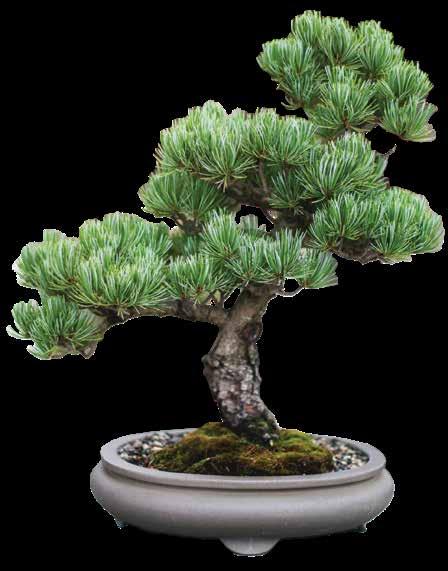
“Water is probably the hardest thing to get a handle on at the start of your bonsai hobby,” said John. Overwatering or underwatering can be detrimental to the tree’s health. John suggests regularly checking the moisture level of the soil by sticking your finger about an inch deep. Only water the bonsai when the top layer of soil feels dry to the touch. “If your tree dries out completely, the top of the soil will become hydrophobic, so you will have to soak the tree to get it to uptake water again,” said John.
Pruning and Shaping
Pruning and shaping are fundamental to maintaining the artistic form of a bonsai. Regularly trim away excess growth to maintain the desired shape and promote healthy development. Use sharp, clean bonsai shears to make precise cuts, avoiding any tearing or damage to the branches. “As a rule of thumb on deciduous trees, trim when the newest growth has hardened off,” said John.
Wiring can also be used to guide the branches gently into the desired position, but it should be done with care and monitored to prevent wire marks. “The best way to learn how to wire is to watch someone experienced or watch online videos. Another way is to cut small branches off of trees in your yard to practice.” said John.
“Pruning and wiring is the best way to keep your tree in shape, but pruning can hurt the tree if done too often,” said John. Each species is a little different when it comes to pruning so it’s best to join a Bonsai Society to learn the intricacies of specific species.”
As bonsai trees grow, they outgrow their pots and require repotting every 2-3 years, a process that rejuvenates their root system. Carefully remove the bonsai from its pot and trim away one-third of the root mass before repotting it in fresh bonsai soil. “When you cut the roots back once you put it back in the soil, the tree will react by growing out new root hairs,” said Norm. These are extensions of the tree’s roots that increase the plant’s nutrient and water intake.
Repotting should be done during the early spring before the tree starts producing new growth. Trees that need repotting usually stop
draining as well; you can test by inserting a chopstick to see how hard the root ball is.
Take the tree out of its pot, work the old soil around the edges and the bottom of the root ball. Trim, overly long, circling roots, or any thick roots that can be safely taken off. You do not have to take all of the old soil away. You can leave a small amount. Repot into fresh soil that drains well; water thoroughly; and keep in shade until you see new growth at the tips.
Keeping your bonsai safe from pests and diseases is important to its survival. “Observe your tree daily, and look for pest and fungal problems,” said John. Webs, holes, or discoloration can be signs of pests or diseases.
Caring for bonsai is not merely gardening, it is an art form that stems from a deep appreciation for nature’s beautiful landscapes. By following these essential tips and guidelines, novices can foster their own artistic connection with bonsai and witness the growth of a living masterpiece! “Just keep in mind the only way you can learn about bonsai or any plant is by making mistakes. Don’t feel horrible if something happens to your first tree,” said John. “Stick with it and you will get better and better.”
So, let your bonsai journey begin, and immerse yourself in the fascinating world of miniature wonders!
Julia Adams recently joined our Gardens Support team as our Horticulturist for the Japanese Garden. A graduate of the University of Tennessee, Julia earned a bachelor’s degree in hospitality and tourism management as well as a degree in plant sciences, concentrating in public horticulture. Previously, Julia has served as an intern at the Denver Botanic Gardens where she worked closely with the director of the Japanese Garden and the Bonsai Horticulturist. This experience sparked Julia’s interest in Japanese gardens and their attentive design, symbolic artistry, and maintenance. Her role in the Hesler Biology Greenhouses, as well as volunteering at UT Gardens in Knoxville, all helped Julia explore her interest and expand her knowledge about this style of gardening. With her extensive knowledge, Julia performs a variety of tasks to ensure that the Japanese Garden thrives.

is pleased to welcome a new staff member.Bonsai photo by Kari-Shea, portrait by Carmen Michael
Explore the Gardens' autumn wonders by joining us for these fun + educational offerings. Learn more and preregister at bbgardens.org.
1. COOL SEASON VEGETABLE GARDENING

Thursday, September 14 | 11 a.m.–noon
Location: Adventure Classroom
Instructor: Jessica Hill (Jones Valley Teaching Farm)
Explore the art and science of cultivating a thriving fall and winter garden by mastering the perfect timing for planting a variety of cool season vegetable species. Leave equipped with the essential knowledge and practical skills needed to create a productive and bountiful garden during the cooler months.
Cost: $20 (Members) | $25 (Nonmembers)
2. COMPOSTING CLASS

Thursday, October 5 | 11 a.m.–noon
Location: Adventure Classroom
Instructor: Bronson Lubresky (Alabama Cooperative Extension System)
Discover the secrets of turning kitchen scraps and yard waste into “black gold” for your garden in this engaging and educational composting class. Join us for a hands-on experience that will teach you the art and science of composting, and equip you with the skills to transform organic materials into nutrient-rich compost to nourish your plants and reduce waste.
Cost: $20 (Members) | $25 (Nonmembers)
3. NATURE JOURNALING
Saturday, October 21 | 10 a.m.–noon
Location: Adventure Classroom
Instructor: Amy Sides
Nature journaling is for everyone! Bring along a sketchbook and pencil, and learn how to record observations of nature with your own drawings and words. Deepen your connection to nature, hone your observation skills, and wake up your curiosity. All ability levels are welcome.

Cost: $20 (Members) | $25 (Nonmembers)
The Library at the Gardens is a wonderful resource for nature enthusiasts, families, and anyone who would like to learn more about gardening. Bring your Jefferson County library card to check out books. Visit the Library 9 a.m.–4 p.m. weekdays.

DINNER & DISCUSSION: PASSALONG PLANTS with Hayes Jackson, Alabama Cooperative Extension Agent, Calhoun County, and director of Longleaf Botanical Gardens in Anniston
Thursday, November 2 | 6 p.m.
Location: Auditorium at Birmingham Botanical Gardens
Cost: $50
Join us for a talk on passalong plants—the ones you can't find in the nursery! Learn about the southern tradition of propagating and sharing native and heirloom plants through generations of gardeners. Dinner will be provided by Whisker's Catfish & BBQ. Beer and wine included.
THYME TO READ
A monthly book club
Every first Tuesday 4:30 p.m.
Location:
Library at the Gardens
Free and open to the public
Tuesday, September 5
“Blue Dahlia” by Nora Roberts

Tuesday, October 10
“The Poison Squad: One Chemist’s SingleMinded Crusade for Food Safety at the Turn of the Twentieth Century” by Deborah Blum

Tuesday, November 7
“Anthill” by E.O. Wilson

4. Our health and wellness classes take place in-person and outdoors. Visit bbgardens. org/classes and follow us on social media for more details and to register.
Location: Moore Cultural Pavilion (Japanese Garden)

Cost: $12 (Members)
$15 (Nonmembers)
ASHTANGA YOGA
Mondays through November
8:30–9:30 a.m.
Instructor: Jason Kirby, Certified Yoga Instructor
TAIJIQUAN (TAI CHI)
YOGA: INTERMEDIATE
Tuesdays through November
4–5 p.m.
Instructor: Stephen Guesman, Tai-Ji Quan Instructor
VINYASA YOGA
Wednesdays through October
8:30–9:30 a.m.
Instructor: Leila Neil, Certified Yoga Instructor
&
5. STORYTIME (Ends on November 3, 2023)
Fridays | 10 a.m.
Location: Southern Living Garden (weather permitting)
Free to all garden visitors
Join us each week with your preschooler for a story followed by a creative craft.

Join us at beautiful Birmingham Botanical Gardens
4
150
THE FRIENDS OF BIRMINGHAM BOTANICAL GARDENS IS pleased to celebrate the 17th Antiques at the Gardens (AATG) this fall. Presented by O’Neal Industries and featuringdesign sponsor de Gournay and textile sponsor Cowtan & Tout, Birmingham’s premier antiques show will once againwelcome a prestigious lineup of nationally and internationallyacclaimed speakers, interior designers, landscape architects, floral artists, and experts on gracious entertaining.
The show will also include 22 celebrated dealers offering furniture, fine art, vintage and fine jewelry, silver, rugs and textiles, home decor, and garden accessories. Shopping hours are 10 a.m. to 5 p.m. on Friday and Saturday, and 10 a.m. to 4 p.m. on Sunday.
Weekend festivities will begin on Thursday, September 28 with the Gala in the Gardens—outdoors and under the stars—sponsored by Mr. and Mrs. James E. Ard and honoring former board chair B. Hanson Slaughter. Guests will arrive
through our Garden entryway created by Zachary J. Westall and available to be admired and enjoyed through the entirety of the event.
Please see the full schedule of panels, lectures, and workshops on page 15. Talks will be followed by book signings, with books available for purchase at Leaf & Petal prior to and during the show.
In its 17th year, the annual show attracts visitors from all over Alabama and across the Southeast. Proceeds benefit the mission of the nonprofit Friends of Birmingham Botanical Gardens, which seeks to protect, nurture, and share the wonders of the Gardens.
For tickets, show schedule, speaker bios, and dealer information, visit bbgardens.org/antiques. Follow show announcements and reveals on Facebook and Instagram @antiquesgardensbham. We look forward to seeing you at Antiques at the Gardens!
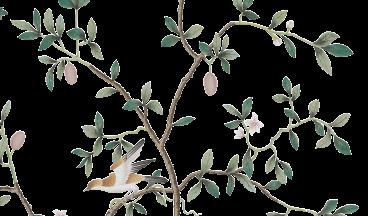
The 2023 Antiques at the Gardens honoree, Hanson Slaughter has given many years of leadership to the Friends of Birmingham Botanical Gardens, including as chair of the development committee and board chair in 2014. Hanson is the managing director of the Birmingham office of 1919 Investment Counsel, a long-term gala sponsor. With a love for gardening running in his family, Hanson Slaughter attributes his support and commitment to Birmingham Botanical Gardens as an inherited passion from his mother and grandmother—one that he hopes to pass along to the greater Birmingham community. “The Gardens are a valuable asset to our community—the seeds being sowed here produce multi-generational benefits,” he says.
O’Neal Industries (ONI) is proud to be the Presenting Sponsor of the 2023 Antiques at the Gardens. For over 40 years, O’Neal Industries has supported the Friends of the Birmingham Botanical Gardens and its mission to promote a love for the natural world. We look forward to hosting an exciting weekend benefitting this vital community asset.
We are honored to feature de Gournay as our 2023 design sponsor. We are extraordinarily delighted that this family company specializing in the creation of the world’s finest hand-painted wallpapers and textiles are joining us for Antiques at the Gardens 2023. de Gournay is applying their bespoke expertise to wallpapers, fabrics, and porcelain, all of which will be showcased throughout the weekend.
We are delighted to welcome Cowtan & Tout as our 2023 textile sponsor. Cowtan & Tout offers exquisite fabrics, trimmings, and wallpapers with a distinctive, American point of view. Tradition is reinterpreted for a modern, classic interior. Cowtan & Tout offers an eclectic selection of prints, wovens, silks, sheers, leathers, trimmings, and wallpapers.
We would like to thank all of our generous patrons and supporters, including presenting sponsor, O’Neal Industries; design sponsor, de Gournay; and textile sponsor, Cowtan & Tout. Your support helps sustain this exceptional Garden. To purchase tickets to our 2023 events, contact the Friends at 205.414.3950 or visit bbgardens.org/antiques. We look forward to seeing you September 28–October 1 at the Gardens!
— Jennifer Ard, Jeremy Clark, and Kirk Forrester

We are grateful for the talents of Zachary James Westall, who is designing and sponsoring the transformation of our plaza for the 2023 Antiques at the Gardens. Zach designs and implements Englishand French-style gardens and native perennial habitats at private estates throughout the U.S. The space can be admired and enjoyed throughout the entirety of our 2023 event.

Sponsored by MK Quinlan
Friday, Sept. 29 at 9:30 a.m.
Join Michael for a special tour of the dealer booths, as he shares recommendations and pieces of interest during this intimate walk-through.
Sponsored by SHOPPE
Our 2023 Gala in the Gardens on Thursday, September 28 promises to be an enchanting black-tie affair! Get your tickets today for this special evening honoring Hanson Slaughter and benefiting the Friends of Birmingham Botanical Gardens. Thank you for joining us to support such a great cause!

— Marguerite Johnson, Rachael Burrow, and Anna Still
Saturday, Sept 30 at 3:30 p.m. Known for his spectacular floral designs marked by a combination of richness and simplicity, Keith will lead participants through his creative process and inspirations as he crafts a signature arrangement for our audience.
Martin Brudnizki is the founder and principal of Martin Brudnizki Design Studio (MBDS), an internationally acclaimed interior architecture and design practice. Hailing from Stockholm, Martin held positions at a number of renowned interior design firms before establishing his eponymous studios in London and New York. He has been described as “one of the best restaurant and hotel designers of his generation.” Notable clients include: Four Seasons, Rosewood Hotels and Resorts, Six Senses Luxury Resorts, The Surf Club, and Royal Academy of Arts. In 2015 Martin established And Objects, a luxury furniture, lighting and accessories design studio. Martin is listed within AD 100, House and Garden Top 100 Leading Interior Designers, and the Elle Décor A-List along with many other recognitions.
Mitchell Owens is the American editor for The World of Interiors. A journalist and lecturer since the 1980s, he specializes in interiors, architecture, gardens, and the history of style. He was also a founding editor of the LGBTQ magazine Out and has co-authored several books.


Book signings to follow
Hannah is the daughter of Claud Cecil Gurney, who founded the English bespoke wallpaper company de Gournay in 1986. She is now the director of the company, renowned for its elegant hand-painted wallpapers and textiles that create some of the most beautiful interiors in the world. Celebrated for its hand-painted chinoiserie wallpapers, sumptuous patterns of colorful flora and varied birdlife, the company produces additional collections that explore historical themes, such as 19th-century French pastoral scenes or exotic Brazilian landscapes bursting with wildlife. de Gournay also crafts more abstracted designs that fit well with modern interiors. It is now a global brand which has expanded into 39 countries, with showrooms in London, New York, Paris, Shanghai, and Moscow, and has representatives worldwide.
Celerie Kemble is a principal in Kemble Interiors, a design firm founded in Palm Beach by her mother, Mimi McMakin. Over the past 22 years, her work has included homes and commercial spaces across the United States and the Caribbean, many of which have been featured in Architectural Digest, House Beautiful, VERANDA, Elle Décor, Traditional Home, LUXE, and more. Celerie is the author of several books: “Island Whimsy,” “To Your Taste,” and “Black & White (and a Bit in Between).” She currently boasts licensed product lines with Schumacher, Arteriors, Lane Venture, Maitland-Smith, and others. Celerie also has an ongoing partnership with Chairish where she offers exclusive product designs and sells most of her lines in one spot.
3. SARAH WETENHALL

Sarah Wetenhall is the owner and CEO of The Colony Hotel and the visionary behind Palm Beach’s historic Pink Paradise. Sarah began her career in New York, spearheading public relations and marketing efforts for major fashion houses. After acquiring The Colony Hotel in 2016 from a previous generation of ownership including her father-in-law, Wetenhall commenced a restoration and relaunch, evolving The Colony into an internationally recognized design-forward hotel. Among her industry-defining projects are the resurgence of the iconic Manhattan boîte, Swifty’s, the lobby transformation featuring bespoke de Gournay wallpaper, the Villa redesigns by Kemble, Aerin Lauder, and Mark D. Sikes, along with fashion partnerships with Bergdorf Goodman, Valentino, Oscar de la Renta, Michael Kors, and Dolce & Gabbana—to name a few. In 2021, she was named one of HOTELS magazine’s Top Ten Independent Hoteliers.


4. MODERATOR STEELE MARCOUX
Steele Marcoux is the editor in chief at VERANDA magazine. She leads editorial initiatives and covers design trends, architecture, and travel.

Book signings to follow
MODERATOR: ANNA BROCKWAY, CO-FOUNDER & PRESIDENT, CHAIRISH

5. ALDOUS BERTRAM Aldous Bertram is an artist, art historian, and interior designer who lives in Charleston, South Carolina. Aldous grew up in England and received his Ph.D. from Trinity College, Cambridge University, specializing in the historical influence of China on English garden design and architecture. He recently published his first book, “Dragons & Pagodas: A Celebration of Chinoiserie.”
6. PALOMA CONTRERAS Houstonbased Paloma Contreras is an interior designer who has repeatedly been named to the prestigious Elle Décor A-List and has also been recognized in House Beautiful’s “Next Wave” designer list and LUXE Magazine’s “Gold List.” She is the author of two books, “Dream Design Live” and “The New Classic Home,” which is slated for an October 2024
release. Her retail shop, Paloma & Co. sources timeless antiques and unique found objects from across the globe and spotlights emerging artists, unique vendors, and curated products.
7. PETER DUNHAM After a childhood in France and college in England, Peter Dunham moved in 1998 to Los Angeles, where he launched his design firm. This was followed by the launch of his eponymous fabric and wallpaper collection in 2003, now sold through 16 showrooms worldwide. In 2007, Peter opened Hollywood at Home, featuring handcrafted furniture, textiles, and vintage finds. Peter is on Elle Décor’s A-List and included in Vendome Press’s new book, “Inspired Design: The 100 Most Important Designers of the Past 100 Years.” His first book will come out in the spring of 2025.


8. MICHAEL DIAZ-GRIFFITH Michael Diaz-Griffith is an art historian, designer, and executive director and COO of the Design Leadership Network. Previously, he served as executive director of Sir John Soane’s Museum Foundation, and associate executive director of The Winter Show. As a consultant, he has advised fairs, auction houses, galleries, and museums on strategy and development, and he was recently named to House Beautiful’s list of “Visionaries” for his advocacy of antiques, historic art, and preservation. “The New Antiquarians: At Home with Young Collectors,” released in June 2023, is his first book.
9. MODERATOR ANNA BROCKWAY Anna Brockway, a self-described vintage fanatic, is co-founder and president of the online marketplace Chairish.


Book signings to follow
MODERATOR: MARGOT SHAW, EDITOR IN CHIEF, FLOWER
10. ZOË DE GIVENCHY Zoë de Givenchy is founder and creative director of luxury brand Z.d.G. From French faïenceand Italian ceramics to Italian linen and French cutlery, Z.d.G. celebrates the finest traditional European craftsmanship and ancient artisanal techniques creating beautiful objects for the home and table. Zoë’s passion for offering beautiful and sustainable products to discerning clients globally has meant the entire supply chain is focused on supporting regional artisans and the communities in which they work, to ensure longevity of these arts.
11. ALEX HITZ Alex Hitz is an award-winning celebrity chef, culinary speaker, columnist, event designer, tastemaker, and expert host. His most recent book, “Occasions to Celebrate: Cooking and Entertaining with Style” features more than one hundred recipes inspired by traditional

Southern fare and French culinary flair. His first book, “My Beverly Hills Kitchen,” and first Rizzoli cookbook, “The Art of the Host,” are widely popular. He is a contributing editor for Town & Country and writes regularly for C Magazine, Quest, and Southern Living. Hitz is a former food editor for House Beautiful, a post he assumed from Ina Garten. He has appeared on numerous television and radio programs, including Today, and lectures frequently around the country. He splits his time between Atlanta, New York City, Los Angeles, and Palm Beach.
12. G. BLAKE SAMS Blake has been an innovator, award-winning tastemaker, and event producer in the creative and special events industry for over a decade. His passion for design and hospitality allows him to thoughtfully create a memorable environment and experience for clients across the globe. Blake’s
work has been featured in Vogue, Harper’s Bazaar, Brides, VERANDA, Elle Décor, Garden & Gun, and many more. He splits his time between New York City and Charleston, South Carolina.


13. SYBIL SYLVESTER Born and raised in Louisiana and Alabama, Sybil is the owner of Birmingham-based Wildflower Designs. Sybil is known for creating stunning flower arrangements and orchestrating take-yourbreath-away events. Her “Flower School” was a popular column in Southern Accents magazine, and her work has been featured in many other publications, including FLOWER Magazine. She is the author of “Fresh,” published in 2017.

14. MODERATOR MARGOT SHAW
Margot Shaw is editor in chief of FLOWER Magazine, a luxury lifestyle publication featuring homes, gardens, and elegant living through a floral lens.

SHOW AMBASSADOR RICHARD KEITH LANGHAM

Alabama-born and Manhattan-based, Richard Keith Langham has been a force in the decorating world for more than 30 years. After graduating from the Fashion Institute of Technology in New York and attending the Center for the History of Fine and Decorative Arts in London, Keith apprenticed with design legend Mark Hampton. He then spent 10 years with Irvine & Fleming before founding his own firm in 1990. Keith's keen eye and ebullient talent serve well in assembling his signature rooms—those that speak to the past in a fresh way and are brimming with luscious color, pattern, and couture detailing. Perhaps no one summed up his aesthetics better than Jacqueline Kennedy Onassis, who once proclaimed him to have “a sorcerer’s eye.”
MODERATOR: HADLEY KELLER, DIRECTOR OF EDITORIAL, DESIGN LEADERSHIP NETWORK
Book signings to follow
Bill Brockschmidt and Courtney Coleman bring to their work a focus on traditional detailing, proportion, materials, and craftsmanship in both architectural elements and in furnishings. They launched their interior design studio, Brockschmidt & Coleman in New York City in 2001, followed by a Southern design studio on Magazine Street in New Orleans in 2019. Their work has been featured online and in print in Frederic, VERANDA, Architectural Digest, Chairish, Departures, Elle Décor, Garden & Gun, House Beautiful, Southern Home, Traditional Home, The New York Times, The Wall Street Journal, and more. Brockschmidt & Coleman has been included on Elle Décor’s A-List annually since 2012.

Architect Stan Dixon is the founder of his eponymous Atlanta-based firm, D. Stanley Dixon Architect. After receiving his degree in architecture from the University of Tennessee and attending Britain’s renowned Attingham Trust School for the Study of Historic Homes and Collections, he honed his craft with the esteemed firm of Norman Davenport Askins. He was named one of The New Faces of Southern Style by Garden & Gun magazine and is a three-time winner of the Southeast Architect of the Year by VERANDA and the Atlanta Decorative Arts Center. Stan is also an eleven-time winner of the Philip Trammell Shutze Award presented by the Southeast Chapter of the Institute of Classical Architecture & Art. Most recently, Stan was awarded the Addison Mizner Medal for his work in Palm Beach. Rizzoli will publish Stan’s first book, “HOME: The Residential Architecture of D. Stanley Dixon” this fall.
3. KEITH ROBINSON

Keith G. Robinson has been a tastemaker and business owner in the Atlanta area for three decades. He is the former creative director/owner of the event-services company Gloriosa, the first turnkey event services company in Atlanta. Keith is known for his restoration of Chattahoochee Hills, Georgia’s 19th-century Hutcheson-Redwine Plantation where he developed exhibition gardens that have been featured in publications including Garden & Gun, Garden Design, Atlanta Homes & Lifestyles, and VERANDA. Most recently, the gardens of Redwine were featured in the book “American Roots.” He was also a contributing editor in VERANDA’s column The Cultivated Life. Keith is now on the executive team of a resort under development at Dunaway Gardens, where he is focusing on the restoration of 22 acres of historic gardens, and spearheading a five-star culinary program.

4. MODERATOR HADLEY KELLER
Hadley Keller is director of editorial and community engagement at the Design Leadership Network, a community of top interior designers. Hadley’s first book, “Beachside: Windsor Architecture and Design,” was published in 2021.



JOIN OUR PERENNIAL LEGACY GIVING CIRCLE
You can help us perpetuate the wonders of Birmingham Botanical Gardens and all that it means to our community and region by including the Friends of Birmingham Botanical Gardens in your planned giving. Every gift makes an impact. Please consider designating the Friends as a beneficiary of your estate through your will, charitable trust, or retirement beneficiary designation. We are grateful to all who have made this special commitment. Please join them in supporting and protecting this beloved community resource. Call Director of Development Penney Hartline at 205.414.3950, ext. 103, to learn more.
THE PERENNIAL LEGACY GIVING CIRCLE
As of July 31, 2023
Recognizing those who have made or pledged a planned gift
Mr.* & Mrs. Edgar G. Aldridge
Mr. & Mrs. Michael Balliet
Ms. Camille A. Becker
Mrs. Lucille S. Beeson*
Peggy Bonfield & Orrin Ford*
Ida C. & D. Joseph Burns*
Mr. & Mrs. Arthur I. Chenoweth*
Mary Carolyn Gibbs Cleveland
Suzanne G. Clisby
Dr. & Mrs. D.C. Coston
Mrs. Martha Stone Cobb Daniel*
The Daniel Foundation of Alabama
Dr. L. Aubrey* & Elizabeth Drewry
The Dunn-French Family
Dr. John D. Elmore*
Martha B. & Robert L.* Eskew
Mrs. Trudy Evans
Mr. & Mrs. Wally Evans
Mrs. Claire H. Fairley*
Bernadine Rushing Faulkner
Mr. F. Lewter Ferrell, Jr.*
Dorothy Ireland Fletcher*
Dr.* & Mrs. Charles P. Grant
Patti Hammond
Jody & Don Hamre*
Penney & Roger Hartline
Mr. R.R. Herbst*
Mrs. Jimmie Hess*
Mr. J. Ernest Hill & Mrs. Ora Lee Hill*
Mrs. Jane Hinds
Fay B. Ireland*
Dr. Susan Jackson
Mr. George L. Jenkins
We sincerely appreciate your generous support, as every contribution can have a significant impact! There are so many ways you can participate: membership, annual donations, memorials and tributes, legacy giving, as well as by volunteering, shopping our plant sales, and joining us for an education program or special event. Please get involved in the Friends and visit often. Thank you for giving back to sustain the Gardens and all it makes possible.
—Penney Hartline, Director of DevelopmentMay-July 2023
Jennifer Ard
Mr. & Mrs. Clark Huddle
Emily Bowron
Garland Cook Smith
Maggie Brooke
Progress Study Club
Molly Carter
Triangle Garden Club
Debbie & D.C. Coston
Elisabeth & Claudia Penry
Richard Cybulsky
Integrative Therapies, Inc.
Kirk Forrester
Walker & Bill Jones
Anna Gainer
Triangle Garden Club
Tricia Noble
Julia Ann & Joe Cleage
Becky Sevier
Triangle Garden Club
Hanson Slaughter
Garland Cook Smith
Charles “Charlie” L. Kinnaird
Ms. Glenda Elliott
George Thomas “Tommy” Lane, Jr.
Mr. Robert M. Cobb
Donie DeBardeleben “D.D.” Neal Martin
Paula & Mike Rushing
Austin Martin Price
Nancy & Jim Price
William Bennett Shamblin
Shannon Waltchack
Janie C. Simpkins
Dona & John Musgrave
John F. Stadtlander
Carolyn E. Stadtlander & Todd H. Emmons
Alvin Ward Vogtle III
Laura K. Vogtle, Ph.D.
Jean Roberson Wall
Mr. & Mrs. Frank Whaley
Andrew James Whalen
The Musgrave Family
John Newton Wrinkle
Mallie & Stewart Dansby
Ms. Lee L. Woehle
Bobbe & Hugh Kaul*
Ms. Pamela Kaul*
Mr. Jason C. Kirby & Mr. Benjamin J. Faucher
Fran Lawlor
William Brock Lewis
Dr. Bodil Lindin-Lamon*
Hope Long
Dr. Michael E. Malone
Annie Lee Buce Matthews*
Ms. Louise T. McAvoy*
Douglas A. & Linda P. McCullough
Margaret H. McGowan*
Mrs. Mary Jean Morawetz
Mr. Philip Morris*
Thelma Vaughan Mueller*
Mr. & Mrs. Fred W. Murray, Jr.
Don & Pat Nelson
Dr. James L. Newsome*
Dr. & Mrs. A. I. Perley*
LeAnne* & Steve Porter
Mrs. Carol P. Poynor
Mrs. Dorothy L. Renneker*
Deborah & John Sellers
Sandra S. Simpson
Mr. & Mrs. William M. Spencer III*
Frederick R. Spicer, Jr.
Mr. Douglas Arant Stockham
Janet & Jarry Taylor
Dr. Wendell H. Taylor, Sr.*
Mrs. Barbara D. Thorne*
Dr. & Mrs.* Jack W. Trigg, Jr.
Mrs. Carolyn D. Tynes*
Mrs. Ann H. “Nancy” Warren*
Mrs. Robert Wells
Anonymous (2)
Patricia Tate
Briarwood Garden Club
May-July 2023
Ruby S. & John P. Ansley
Mr. & Mrs. Claude C. White, Jr.
Pamela Bachmuth
Mr. Joel S. Isenberg & Mr. John T. McGill
Baby Doores
Mr. & Mrs. Bob Lindstrom
The Honorable Anne Dahlene
Lamkin Durward
Dr. & Mrs. Tom McKinnon
Martha Bonner Eskew
Les Jeunes Meres Club
Mrs. Lee E. Chapman
Lynette Estock Evans
Mr. & Mrs. Andrew Grainger
Sheila Banish Huddleston
Linda & Butch McIntosh
Susan & John McIntosh
Cindy & John Tummons
Cathy & Warren Whatley
Mr. & Mrs. Stephen T. Whittle
Anonymous
Robert L. Eskew, Sr.
Mr. & Mrs. John R. Eskew
Anonymous
Patricia Camp Faulkner
Mr. & Mrs. Willard McCall, Jr.
Hewlett Chervis Isom, Jr.
Mary Kate, Ginger & Tom Dyer
May-July 2023
William Bishop
Lois Chaplin
Rebecca Cohn
Cathy O’Sheal
Sandra S. Simpson
Jason Kirby
Kirkwood by the River in honor of Wildflowers Garden Club
Helen Person
Edgewood Garden Club
George Zary
Steve Zary
 By MOLLY HENDRY
By MOLLY HENDRY
As Halloween approaches, the world around us takes on an eerie aura, with chilling tales and haunted legends seeping into our daily lives. While we often associate Halloween with ghosts, ghouls, and witches, the natural world also holds its fair share of rather creepy plants. Among the shadows of the plant kingdom lie some spine-chilling specimens that are sure to give you shivers! Join us as we unearth the secrets of spooky plants.
1. TOOTHACHE TREE Zanthoxylum clava-herculis
Ouch! This tree will pack a frightening punch with its spiny trunk, often giving it the name Hercules club. If giant thorns aren’t enough, the leaves and bark of this native shrub can numb your mouth if chewed! (Barber Alabama Woodlands)
2. DEVIL’S WALKING STICK Aralia spinosa
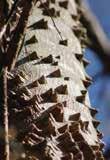

This shrub will grow where other species dare not tread, often as a pioneering species in harsh conditions. Good luck trying to remove this native wonder—its spiny stalks will have the last laugh! Yikes, spikes! (Kaul Wildflower Garden)
3. WHITE-TOPPED PITCHER PLANT Sarracenia leucophylla

Bugs of the air, beware! This is an insect-eating machine lying in wait within Alabama’s bogs. The sweet nectar around the rim of the plant draws unsuspecting prey to the vase-like leaf, coating them in a slippery film that causes them to fall to their sudden end. A yummy snack for a pitcher plant! (Kaul Wildflower Garden and the Plant Adventure Zone)
4. AMERICAN AGAVE Agave americana

You might not find much to be scared of when you first lay eyes on an agave. But, perhaps you would whistle a different tune if you saw the massive yellow flowers being swarmed by bats in the dead of night, drawn to the copious amounts of pollen. (Ireland Iris Garden)
5. SPIDER PLANT Chlorophytum comosum
If there was ever a plant guaranteed to give you a jumpscare while at your local plant nursery, it is this one! Imagine looking up and seeing tiny spiders swinging down toward you on thin threads—oh wait, it’s just a spider plant. But that’s the only intimidating aspect about this plant, as it is a common houseplant and easy to care for, provided you don’t overwater it!

Birmingham, Alabama 35223

205.414.3950
bbgardens.org
Thank you for your commitment to this community treasure. Your support is vital for the Gardens and those we serve. Please renew or upgrade your membership at bbgardens.org/membership.
